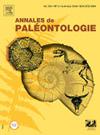重新审视僧伽罗豹:来自斯里兰卡的全型标本的形态学见解和进化意义
IF 0.7
4区 地球科学
Q4 PALEONTOLOGY
引用次数: 0
摘要
狮子(Panthera leo)的进化史揭示了一个由环境变化、地理分散和对猎物的适应所塑造的动态轨迹。跨越一百万年的化石证据强调了它们的起源、活动范围的扩展,以及最终分化成各种亚种,包括现代狮子。本研究提供了狮子物种的比较分析,重点是已灭绝的Panthera leo sinhaleyus,通过检查牙齿形态特征-特别是冠高和冠宽。Panthera leo sinhaleyus于1938年在斯里兰卡Rathnapura地区的Kuruvita被发现,它是通过完整模式标本(即左下卡尼塞尔)而闻名的。这个标本是与属于晚更新世的灭绝动物群一起发现的。自从它被发现以来,关于它与亚洲、非洲和欧洲当代狮子物种的时间和分类范围的研究一直很有限。我们的统计分析显示,黑豹具有明显的中间牙齿特征。其冠高(29 mm)超过了现代美洲豹(Panthera leo)的平均冠高(26.9 mm),但仍低于中更新世美洲豹(Panthera spelaea)的冠高(32.36 mm)。同样,它的冠宽(14.5 mm)比黑豹(Panthera leo)的许多亚种宽,但比黑豹(Panthera spelaea)的冠宽(18.19 mm)窄。这些发现表明,斯里兰卡更新世Panthera leo sinhaleyus表现出可能反映其环境的适应性,表明其具有独特的生态位和进化轨迹。本研究强调了进一步研究史前狮子的年代和分类位置的必要性,有助于更广泛地了解史前狮子物种的形态多样性和进化途径。本文章由计算机程序翻译,如有差异,请以英文原文为准。
Revisiting Panthera leo sinhaleyus: Morphological insights and evolutionary implications from the holotype specimen from Sri Lanka
The evolutionary history of lions (Panthera leo) reveals a dynamic trajectory shaped by environmental shifts, geographic dispersal, and adaptations to prey availability. Fossil evidence, spanning over a million years, underscores their origins, range expansions, and eventual divergence into various subspecies, including modern lions. This study provides a comparative analysis of lion species, with a focus on the extinct Panthera leo sinhaleyus, through an examination of dental morphological traits — specifically crown height and crown breadth. Panthera leo sinhaleyus, discovered in 1938 at Kuruvita, in the Rathnapura district, Sri Lanka, is known from the holotype specimen (i.e., a left lower carnassial). This specimen was found in association with extinct fauna assigned to the Late Pleistocene. Since its discovery, there has been limited research addressing its chronological and taxonomic range in relation to contemporary lion species, from around Asia, Africa and Europe. Our statistical analyses reveal that Panthera leo sinhaleyus exhibits distinct intermediate dental characteristics. Its crown height (29 mm) surpasses that of the modern Panthera leo (26.9 mm on average) but remains smaller than that of the Middle Pleistocene lion Panthera spelaea (32.36 mm). Similarly, its crown breadth (14.5 mm) is broader than many subspecies of Panthera leo yet narrower than Panthera spelaea (18.19 mm). These findings suggest that Panthera leo sinhaleyus exhibits adaptations potentially reflective of its environment in Pleistocene Sri Lanka, indicating a distinct ecological niche and evolutionary trajectory. This study underscores the need for further investigation into the chronological and taxonomic placement of Panthera leo sinhaleyus, contributing to a broader understanding of morphological diversity and evolutionary pathways among prehistoric lion species.
求助全文
通过发布文献求助,成功后即可免费获取论文全文。
去求助
来源期刊

Annales de Paleontologie
地学-古生物学
CiteScore
1.70
自引率
10.00%
发文量
8
审稿时长
>12 weeks
期刊介绍:
Créées par Marcellin Boule en 1905, les Annales de Paléontologie publient 4 numéros par an traitant des fossiles animaux et végétaux, dans tous les domaines de la paléontologie incluant :
-La Paléoanatomie-
La Paléohistologie-
La Morphologie fonctionnelle-
La Systématique-
L''Évolution-
La Paléoécologie
... et toute les contributions susceptibles d''améliorer la compréhension des organismes et des environnements éteints.
 求助内容:
求助内容: 应助结果提醒方式:
应助结果提醒方式:


